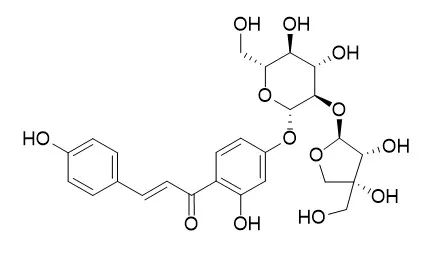| In vitro: |
| J Agric Food Chem. 2005 Sep 21;53(19):7408-7414. | | Isolation and identification of flavonoids in licorice and a study of their inhibitory effects on tyrosinase[Pubmed: 16159166] | | Five different flavonoids were isolated from licorice after multistep chromatographic fractionation. The aim was to identify and characterize active components in licorice responsible for antibrowning activities and to seek new tyrosinase inhibitors for applications as antibrowning and depigmenting agents in the food and cosmetic industries. The isolated flavonoids were identified as liquiritin, licuraside, isoliquiritin, liquiritigenin (from Glycyrrhiza uralensis Fisch.), and licochalcone A (from Glycyrrhiza inflate Bat.) by UV, MS, (1)H NMR, and (13)C NMR analyses. The inhibitory potencies and capacities of these flavonoids toward monophenolase activity of mushroom tyrosinase were investigated. The IC(50) values of licuraside, isoliquiritin, and licochalcone A for monophenolase activity were 0.072, 0.038, and 0.0258 mM, respectively. A study of the mechanisms of monophenolase inhibition by these flavonoids indicated that they are all competitive inhibitors. Different from the above flavonoids, no inhibitory activity was observed for liquiritin, whereas liquiritigenin activated the monophenolase activity as a cofactor. The inhibitory effect of licuraside, isoliquiritin, and licochalcone A on diphenolase activity with l-DOPA as the substrate was much lower than those with l-tyrosine. Results suggest that licuraside, isoliquiritin, and licochalcone A have the high potential to be further developed into effective antibrowning and depigmenting agents. | | Planta Med . 1989 Feb;55(1):22-26. | | The existence of aldose reductase inhibitors in some kampo medicines (Oriental herb prescriptions)[Pubmed: 2497475] | | Traditionally in Japan, some kampo medicines which contain Glycyrrhizae radix (GR) and Paeoniae radix (PR) have long been used for the treatment of diabetic neuropathy. Since we have previously shown that GR und PR have potent aldose reductase inhibitory activities, we further investigated the constituents of these two. The boiled water extract of GR was applied to Sephadex LH-20 column chromatography and 6 fractions (Frs. A, B, Cs, Cp, D, and E) were obtained. Frs. Cp and D were retreated in the same manner and 7 pure compounds (GUs 1-7) were obtained. The boiled water extract of PR was fractionated with ethyl acetate followed by n-butanol and 3 fractions (Frs. 1-3) were collected. Fr. 1 was retreated in the same manner and 2 pure compounds (PRs 1 and 2) were obtained. Among the GU compounds, GU-2 was the most potent inhibitor of rat lens aldose reductase (RLAR) by inhibiting 86% at the concentration of 1.0 microgram/ml. The IC50 of GU-2 was 7.2 x 10(-7) M. Furthermore, GU-2 markedly inhibited sorbitol accumulation in human red blood cells, having an IC50 of 2.9 x 10(-5) M. GU-5 and PR-1 also inhibited RLAR (IC50: 5.6 x 10(-7) M and 6.3 x 10(-7) M, respectively). The structures of GU-2, GU-5, and PR-1 were identified as isoliquiritin, licuraside, and 1, 2, 3, 6-tetra-O-galloyl-beta-D-glucose, respectively.(ABSTRACT TRUNCATED AT 250 WORDS) | | Anticancer Res. 2013 Aug;33(8):3061-3068. | | Evaluation of cytotoxiciy and tumor-specificity of licorice flavonoids based on chemical structure[Pubmed: 23898061] | | Background: The mechanism of cytotoxicity induction by flavonoids has been studied by many investigators, but their tumor specificity is not clear. To address this point, 10 licorice flavonoids were subjected to quantitative structure-activity relationship (QASR) analysis with cytotoxicity assay with four human oral carcinoma and three normal cell lines.
Materials and methods: Cytotoxicity was determined by the 3-[4,5-dimethylthiazol-2-yl]-2,5-diphenyltetrazolium bromide method. Physico-chemical, structural, and quantum-chemical parameters were calculated based on the conformations optimized by the LowModeMD method.
Results: Licurazid and isoliquiritigenin had the highest cytotoxicity against tumor cells, and liquiritin, isoliquiritin and licurazid had the highest tumor specificity, suggesting an antitumor potential for licurazid. Chalcones had slightly higher cytotoxicity and tumor specificity than flavanones. The number of sugar units in the molecule was somewhat negatively-correlated with cytotoxicity, but not with tumor specificity. Parameters that reflect the three-dimensional structure, molecular volume and number of phenolic OH groups were significantly correlated with cytotoxicity, but not with tumor specificity. On the other hand, solvation energy was significantly correlated with tumor specificity, but not with cytotoxicity.
Conclusion: These physicochemical descriptors may be useful to estimate cytotoxicity or tumor specificity of structurally-related compounds to these licorice flavonoids. |
|






 Cell. 2018 Jan 11;172(1-2):249-261.e12. doi: 10.1016/j.cell.2017.12.019.IF=36.216(2019)
Cell. 2018 Jan 11;172(1-2):249-261.e12. doi: 10.1016/j.cell.2017.12.019.IF=36.216(2019) Cell Metab. 2020 Mar 3;31(3):534-548.e5. doi: 10.1016/j.cmet.2020.01.002.IF=22.415(2019)
Cell Metab. 2020 Mar 3;31(3):534-548.e5. doi: 10.1016/j.cmet.2020.01.002.IF=22.415(2019) Mol Cell. 2017 Nov 16;68(4):673-685.e6. doi: 10.1016/j.molcel.2017.10.022.IF=14.548(2019)
Mol Cell. 2017 Nov 16;68(4):673-685.e6. doi: 10.1016/j.molcel.2017.10.022.IF=14.548(2019)